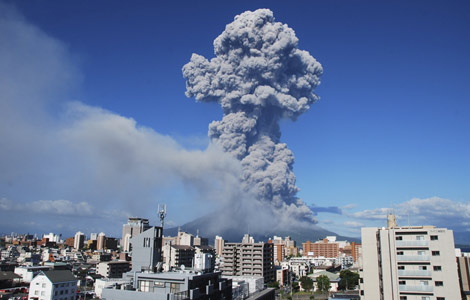China defense chief and Hagel need to find balance for Pacific
Updated: 2013-08-19 10:47
By J. Stapleton Roy (China Daily)
|
||||||||
China's Defense Minister, General Chang Wanquan, started his visit to the United States at the invitation of US Defense Secretary Hagel. This is a welcome development. The two leaders have much to talk about.
Sino-US relations have been marked by growing strategic rivalry, as each side seeks to maximize its ability to defend its fundamental national interests. China's military modernization programs are designed to strengthen what it calls its counter-intervention operations, or what Americans call its anti-access/area denial capabilities. These include the development of a ballistic missile that could pose a threat to the operation of US aircraft carriers in the western Pacific.
The US has responded by developing an Air-Sea Battle concept, under which US military forces are strengthening their capabilities to deter and, if necessary, neutralize threats to their ability to operate in East Asian waters. This would necessarily entail having the capability to take out targets on the China mainland that are integral to the threat.
Top leaders in both China and the US are concerned about the growing strategic rivalry between the two countries. They are conscious of the historical examples, where the clash of interests between rising powers and established powers has precipitated bloody conflicts. They have endorsed the concept of trying to create a new model of major power relations between China and the US that can prevent history from repeating itself. Whether this will be possible remains to be seen.
This poses the question of how to bring the military activities of each side into conformity with the strategic goal of limiting further growth in strategic rivalry between the two countries. In addressing this question we confront a number of difficult issues.
The first is the question of how to limit escalation between countries each of which possesses a retaliatory nuclear capability. In a confrontation between nuclear powers, any military concept that poses the risk of escalation to the point of attacks by one country on the homeland of the other is not operationally useable except under the direst of circumstances. Washington and Moscow could never solve this strategic problem during the Cold War, a reality that effectively deterred the US and the Soviet Union from getting into direct conflict. There is no reason to believe that we are any closer now to a solution.
To a significant degree, controlling escalation depends on the ability of each side accurately to read the bottom line of the other. Historical examples are not encouraging in this respect. The risk of miscalculation is also increased by the propensity of some Chinese strategists to assume that China has a greater national interest than that of the US in some of the potential war-fighting scenarios in East Asia, and that China will thus be able to face down the US in a crisis.
A further question that military leaders on each side need to address is whether it is possible to establish at the operational level a stable, conventional military balance throughout the western Pacific region that meets the fundamental security interests of each side. A major driver of the growing strategic mistrust between China and the US is the understandable desire of each side to have a military balance that favors its interests.
This is a natural preference, but it will not contribute to developing a new model of major power relations. Taking into account both geographic and historical factors, it is reasonable to suppose that a stable military balance must be based, as a minimum, on an improved ability by China to defend its own territory, and a US military posture in the western Pacific sufficiently strong to support the credibility of its defense alliances.
This is the dilemma that national and defense leaders need to address: is there a way to strike a stable balance between China's fundamental interest in defending its own territory and the fundamental American interest in preserving the credibility of US alliances? What is needed is some form of mutual assured restraint.
Historical experience suggests that barring the collapse of either side, there is no way to strike such a balance based on military capabilities alone. In short, this is not a defense problem but a problem of grand strategy, in which military capabilities must be viewed as only one element in an approach in which diplomacy, trade, and other components of national power must all be brought into play. Focusing on the military component in isolation from these other considerations will not resolve the dilemma. A more comprehensive approach is needed.
Hopefully, the discussions between PRC Defense Minister Chang and US Defense Secretary Hagel will move us closer to defining what this approach should be.
The author is a former US mbassador to China and a distinguished scholar at the Wilson Center in Washington, DC.
(China Daily USA 08/19/2013 page11)

 Ride to fly on the top of mountains
Ride to fly on the top of mountains
 Nadal beats Isner to win first Cincinnati crown
Nadal beats Isner to win first Cincinnati crown
 Wild Africa: The new attraction to Chinese tourists
Wild Africa: The new attraction to Chinese tourists
 Azarenka beat Williams for Cincinnati title
Azarenka beat Williams for Cincinnati title
 500th eruption of Sakurajima Volcano in 2013
500th eruption of Sakurajima Volcano in 2013
 A cocktail that's a treat for the eyes
A cocktail that's a treat for the eyes
 Private sector to care for the elderly
Private sector to care for the elderly
 Be innovative, Li tells graduates
Be innovative, Li tells graduates
Most Viewed
Editor's Picks

|

|

|

|

|

|
Today's Top News
Iran signals willingness to resume nuclear talks
Baby formula sales to be shifted to pharmacies
CIA document release acknowledges Area 51
36 killed in Egypt's prison truck escape attempt
Be innovative, Premier Li tells graduates
Onus on US to improve military ties
Trustee council may be answer for reforming
40 killed as floods ravage NE China
US Weekly

|

|







